This post may contain affiliate links. Please read our disclosure policy.
How to blanch and freeze asparagus, plus cook asparagus from frozen following a simple step-by-step process and top tips!
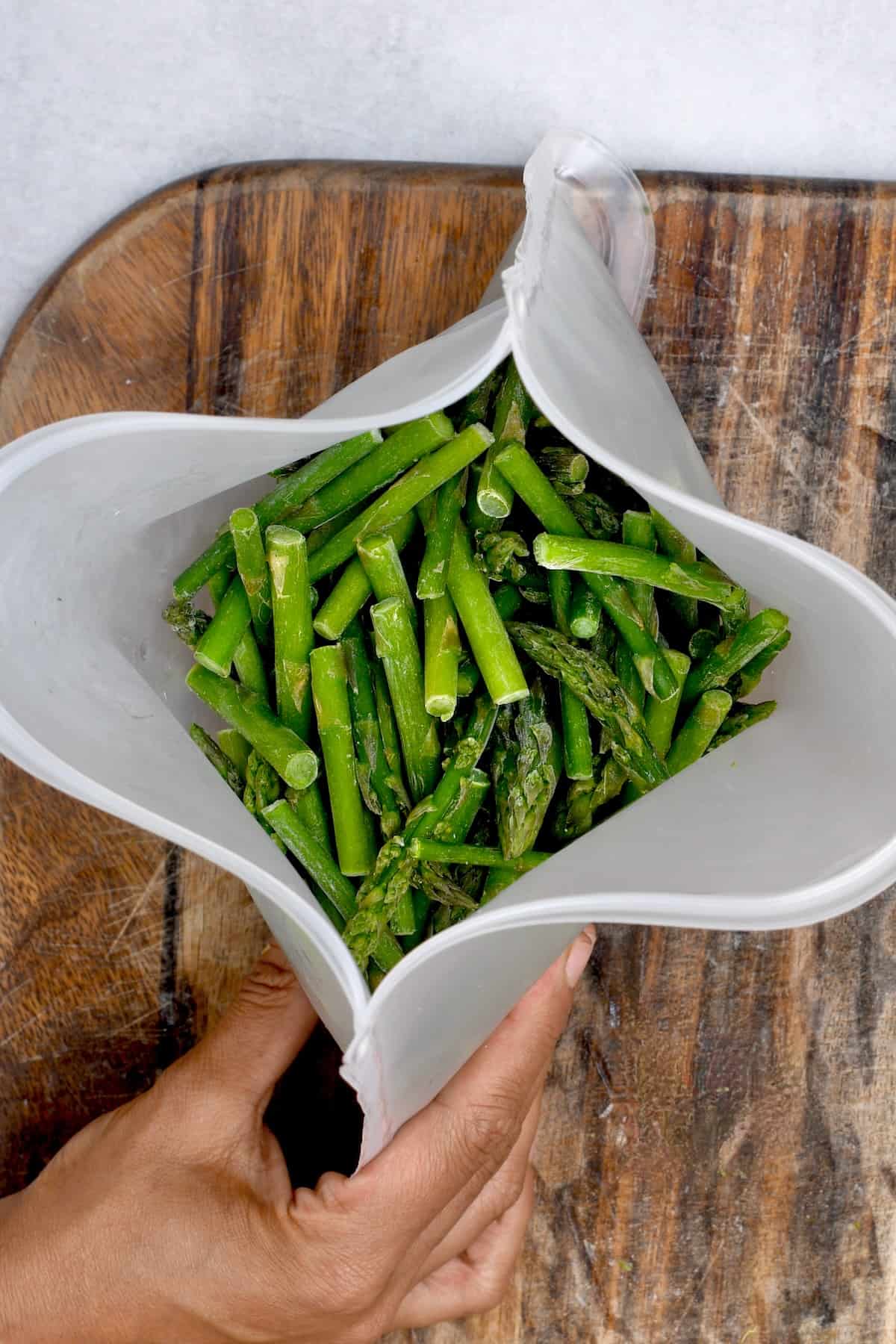
Even when following all the top tips on how to store fresh asparagus in the refrigerator, it is only going to last you about 5 days. When combined with its short peak season, I’ve found that freezing asparagus is the perfect way (other than pickling!) to enhance its shelf life, avoid waste, and make the most of this vegetable practically year-round.
Unfortunately, just shoving the spears in a freezer bag and calling it a day isn’t going to cut it. However, following a simple method for blanching, you can preserve the color, texture, flavor, and nutritional value of the veggie. It will be perfect for adding to casseroles, risotto, pasta, stir-fries, and more.
Want to save this recipe?
How to prepare fresh asparagus for breezing
It’s important to start with fresh produce before we learn how to freeze asparagus. Look out for stalks that are firm, smooth, and stand upright (not limp/wilting).
They should also be a rich green color at the top (unless you’re using white or purple), with no mush/mold. Asparagus peak season is Spring, best between April/ May.
The first step is to trim the woody ends of the stalks. First, bend the bottom of a stalk until it snaps. Then line up the ends of a handful of spears on a cutting board and use a chef’s knife to trim the same amount from them all. Repeat with the remaining spears.
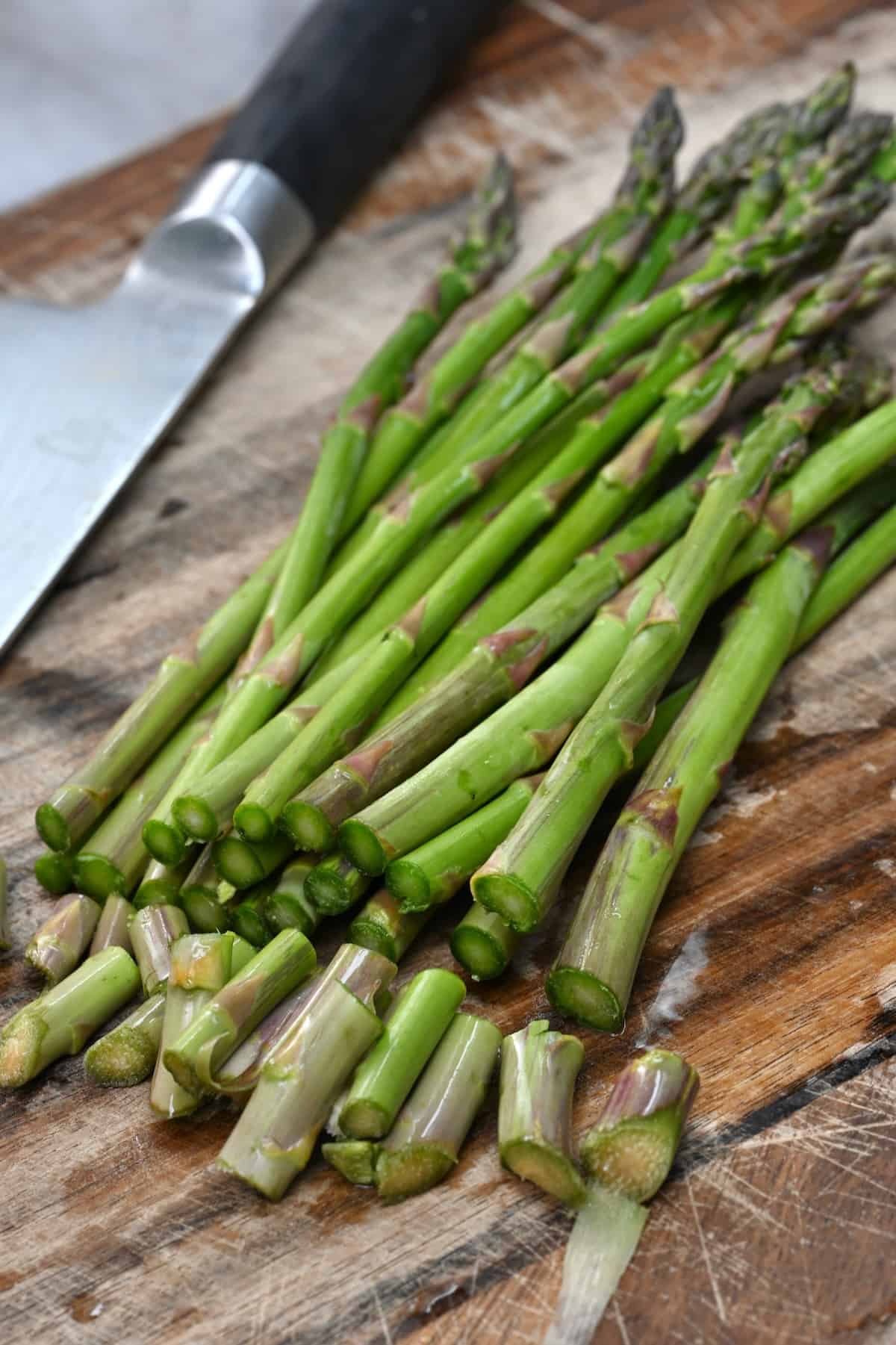
If your stalks are particularly wide, they may also have a tough peel on the stalk, so feel free to use a vegetable peeler to peel it. This isn’t necessary for small/medium stalks.
Meanwhile, bring a large pot of water (lightly salted if preferred) to a boil. Once boiling, carefully lower the asparagus into the water using tongs or a slotted spoon.
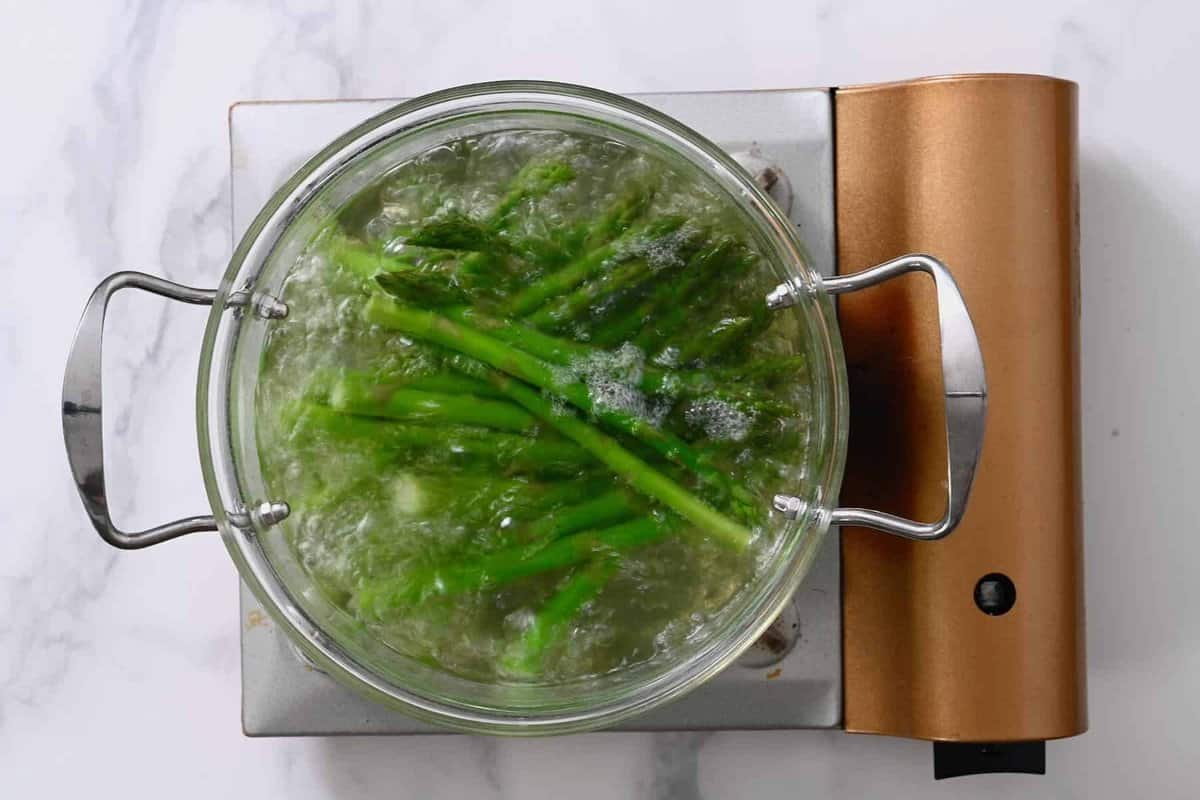
Alternatively, you can steam-blanch the veggie by placing a steaming basket in a large pan with a lid and cooking it for 3-6 minutes based on its thickness.
How Long to Blanch Asparagus Before Freezing?
The time to blanch depends on its size/thickness. For very thin spears, 1-1:30 minutes is enough. For medium spears, 2 minutes should work great. And, for large/extra-large spears, I recommend 3-4 minutes.
It is ready when it has a bright, vibrant green color with a crisp-tender texture.
Once the time is up, use tongs to transfer the asparagus to an ice bath (large bowl of ice water) to halt the cooking process. Allow it to sit in the water for about 5 minutes or until entirely cooled.
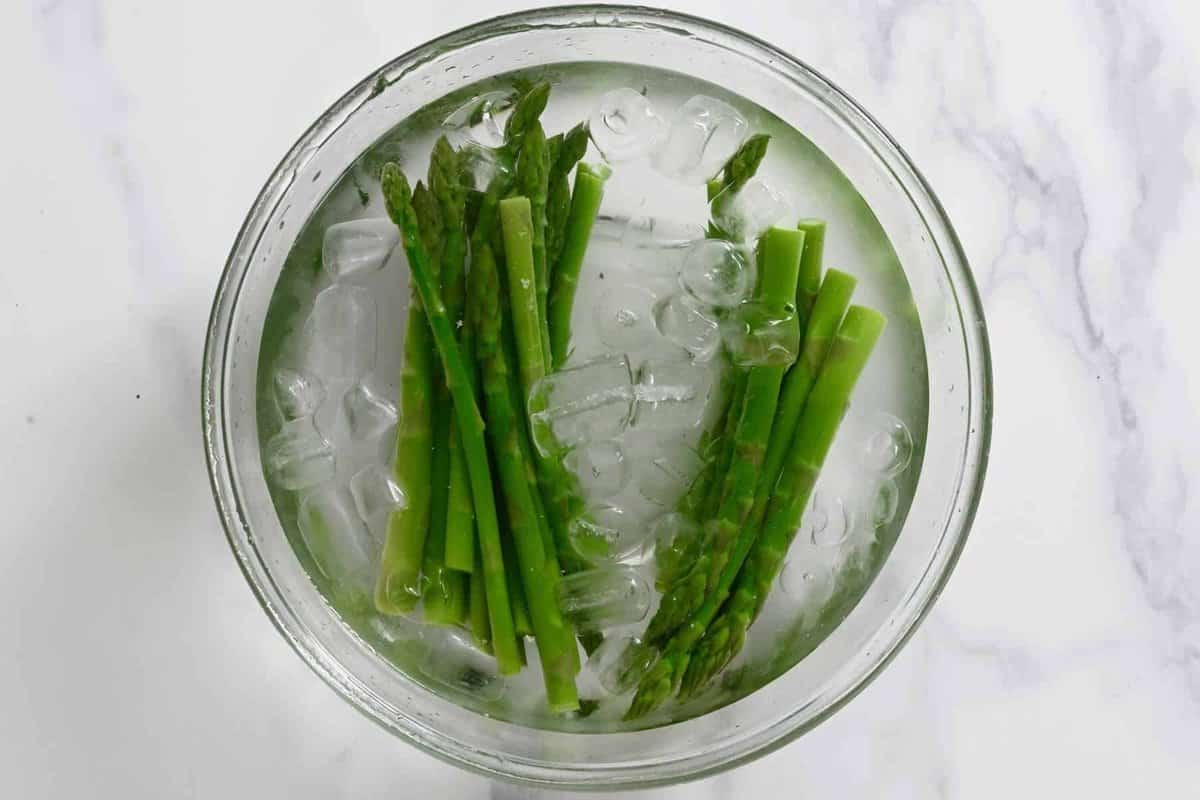
Once cool, transfer to a clean kitchen towel to drain and carefully pat the spears dry. If wanted, now is the time to cut them down into smaller 1-2-inch pieces.
How to freeze asparagus
First, spread the blanches spears across a large baking sheet in a single layer, ensuring they aren’t touching. Then transfer the tray to the freezer to flash freeze for 1-2 hours until they’re solid.
This step ensures they won’t stick together when frozen, so it’s easy to thaw only as much as you need each time.
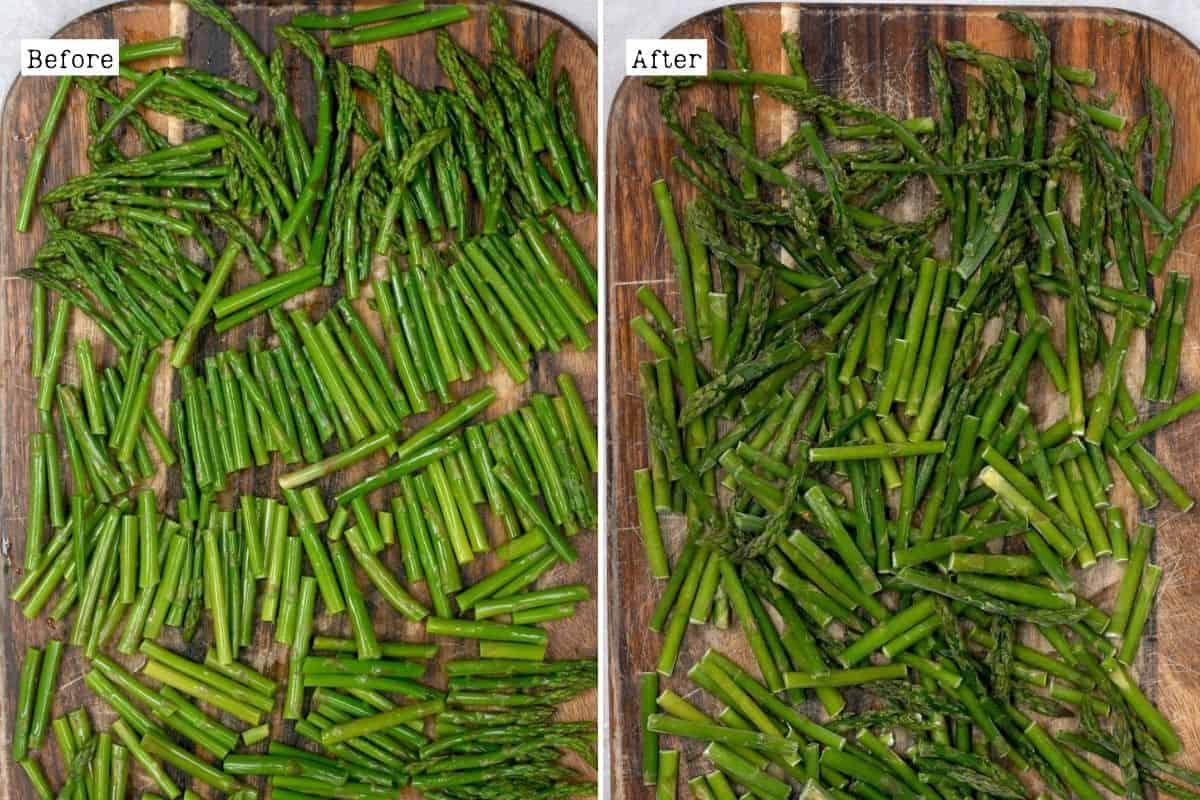
Finally, transfer the spears to an airtight container or freezer bag (push as much air out as possible then seal).
Can you freeze asparagus raw without blanching it
Technically, freezing fresh asparagus is possible by placing them directly into the freezer-safe container. However, I wouldn’t recommend it as blanching asparagus is essential for several reasons:
- Enhancing its color and flavor. The blanched stalks are vibrant green. The process also helps remove any bitterness from the veg.
- Maintaining its texture. That way, it will taste as close to fresh as possible, even after freezing and thawing. Frozen raw asparagus is likely to become mealy/mushy.
- Extending its shelf–life. While blanching, the boiling water will destroy bacteria and enzymes that cause spoilage.
How long can you freeze asparagus for?
You can store blanched fresh asparagus in the fridge for 3-4 days after blanching.
Alternatively, the frozen veg will store in the freezer for between 6-8 months for the best quality (flavor and texture), though it technically lasts up to 12 months.
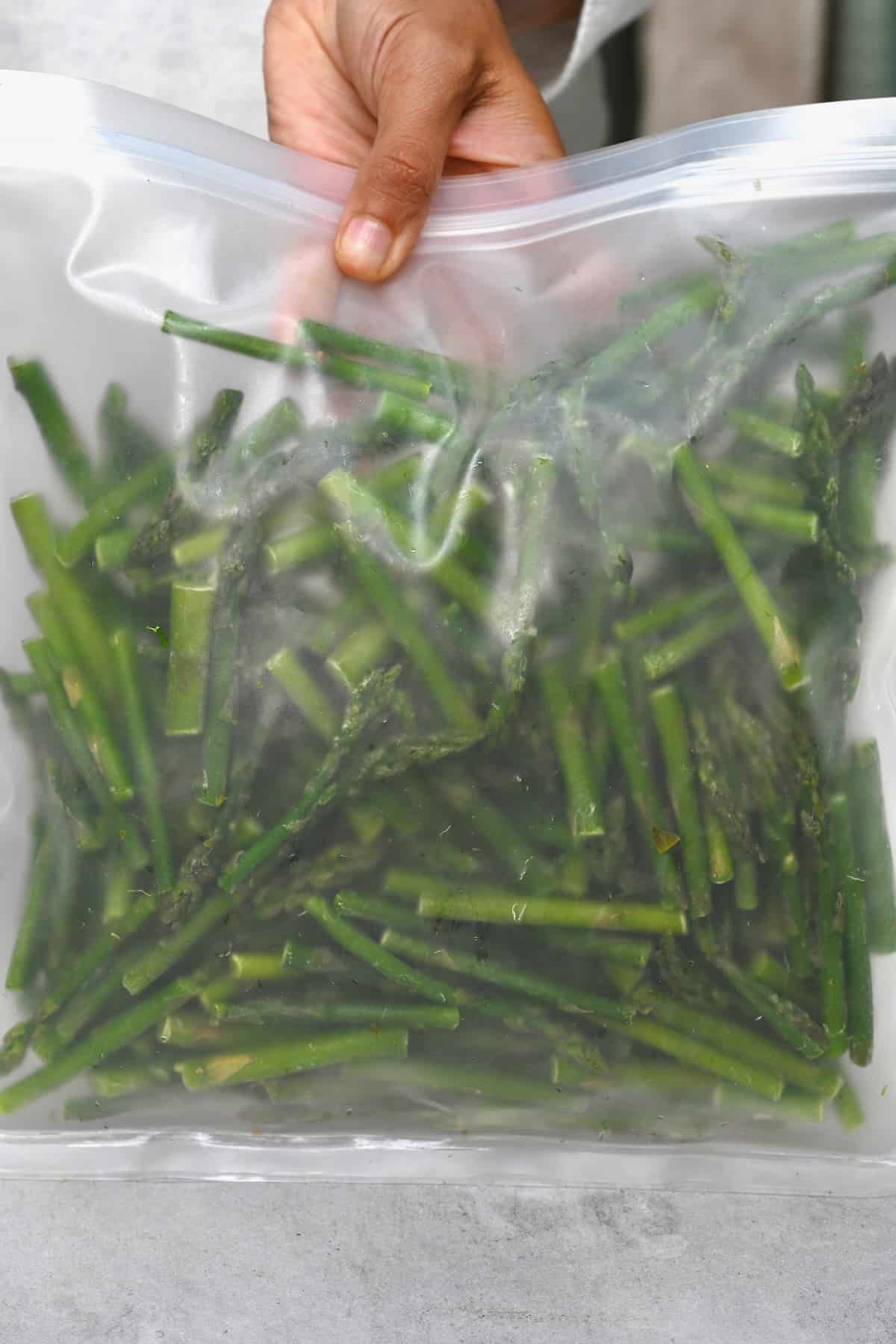
How to use frozen asparagus
There’s no need to defrost frozen asparagus before cooking it (yay!). I love to throw it directly into dishes in the last few minutes of cooking on the stove or before baking them.
Because the frozen spears will become tender upon cooking, I prefer using them in recipes where the tender texture works well. I.e., cream of asparagus soup, stews, casseroles, vegetable stir-fries, one-pot pasta bakes, risotto, quiche, etc.
To cook just the frozen asparagus. My preferred method is to add it to a pan and sauté the asparagus with a little olive oil or butter for just 1-2 minutes (depending on its size) until tender and hot-through.
More ways to use asparagus
If you try this easy method on how to freeze asparagus, let me know how it goes in the comments below. I’d appreciate a recipe card rating and would love to see your recipe recreations – tag me on Instagram @Alphafoodie!
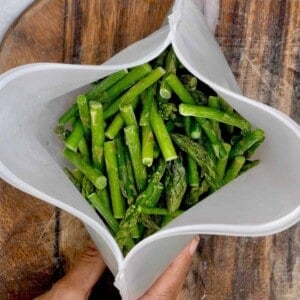
How to Freeze Asparagus
Ingredients
- 14 oz asparagus or as much wanted/needed
Instructions
Prepare the Spears
- Trim the woody ends of the stalks. First, bend the bottom of a stalk until it snaps. Then line up the ends of a handful of spears on a cutting board and use a chef’s knife to trim the same amount from them all. Repeat with the remaining spears.If the stalks are particularly wide, they may also have a tough peel on the stalk, so feel free to use a vegetable peeler to peel it. This isn't necessary for small/medium stalks.
Blanch
- Bring a large saucepan of water (lightly salted if preferred) to a boil. Once boiling, carefully lower the asparagus into the water using tongs or a slotted spoon.
- The time to blanch asparagus depends on its size/thickness. For very thin spears, 1-1:30 minutes is enough. For medium spears, 2 minutes should work great. And, for large/extra-large spears, I recommend 3-4 minutes.It is ready when it has a bright, vibrant green color with a crisp-tender texture.
- Once the time is up, use tongs to transfer the stalks to an ice bath (large bowl of ice water) to halt the cooking process. Allow it to sit in the water for about 5 minutes or until entirely cooled.
- Once cool, transfer to a clean kitchen towel to drain and carefully pat the spears dry. If wanted, now is the time to cut them down into smaller 1-2-inch pieces.
Freeze
- Spread the spears across a large tray in a single layer, ensuring they aren't touching. Then transfer the tray to the freezer to flash freeze for 1-2 hours until they're solid.This step ensures they won't stick together when frozen, so it's easy to thaw only as much as you need each time.
- Transfer the spears to an airtight container or freezer bag (squeezing out any excess air).Store in the freezer for 6-8 months for the best quality (in terms of flavor and texture), though it technically lasts up to 12 months.
Notes
- Use the best asparagus: Make sure it’s fresh, in-season, and not past its best.
- Save any scraps: The ends can be added to a freezer bag of veggie scraps to turn into vegetable stock or asparagus end soup.
- Thicker asparagus freezes better: Because very thin spears (pencil thickness or less) are naturally more tender, they’re more likely to become mushy upon thawing.
- Don’t blanch too much at one time: It will cause the water temperature to drop, and it won’t blanch evenly. Generally, I recommend blanching about 14 oz at a time.
- Blanch by size: If your bundle of asparagus comes in various thicknesses, it’s best to blanch them in batches so none are over or under-blanched. Start by adding the thicker spears to the water, then add the rest incrementally based on their size and recommended blanching time.
- Have the ice bath ready: Before you blanch the asparagus, have the bowl of ice water ready to immediately transfer it.
- Thoroughly dry the spears: This will prevent ice crystals and stop the asparagus from becoming mushy upon thawing.
Nutrition
Nutrition information is automatically calculated, so should only be used as an approximation.












